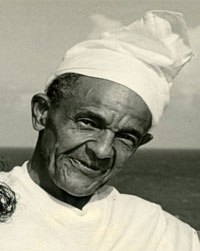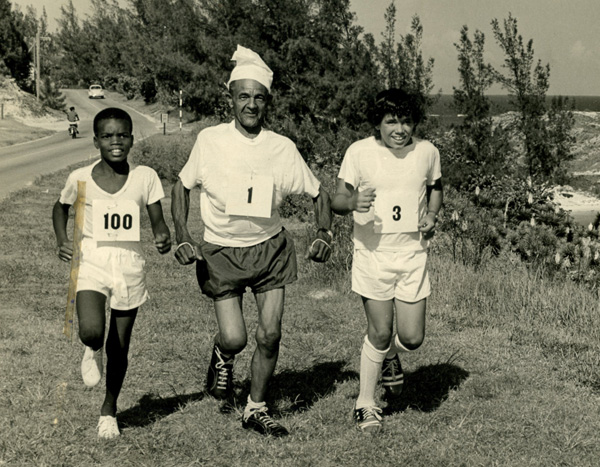- Biography
- Milestones
- Quotes
- Photos
- Learn More
Stanley Burgess
September 10, 1901-June 3, 1984
Marathon Derby legend, fisherman | 
| Stanley Burgess was one of the Island’s most enduring and colourful sports legends. A perennial competitor in the annual Bermuda Day Marathon Derby on May 24, he was a fixture in road running for 60 years. His running prowess earned him a litany of titles. The diminutive champion, who stood only five-foot three, was known as ‘The Iron Horse’, ‘Mr. Marathon’ and ‘The Champ’. Later, as his popularity increased with age, he was called ‘Grand Old Man’ of the Marathon Derby and even ‘Sir’ Stanley.
One of his biggest fans was former headmaster, Dale Butler, who is now an MP. When Butler was principal of Dellwood School, he set aside May 23 as a day for his students to celebrate Burgess’ achievements.
Handkerchief
Burgess ran his first marathon in 1921 and his last in 1983—13 months before his death at age 83. He always ran with his trademark white handkerchief wrapped backwards around his head, which added to his appeal.
His talent and homespun tips for winning helped contribute to the popularity of the Marathon Derby, which grew by fits and starts over the decades. It now attracts more than 500 entrants, thousands of spectators and is the signature event of the Bermuda Day holiday.
Burgess smoked two packs of cigarette a day—but claimed he didn’t inhale— and drank a “secret” potion of honey and liquor, but had an otherwise healthy lifestyle, literally living off the land and the sea.
He was a mason, who went fishing in his beloved cedar sailboat most days, and a beekeeper who also farmed a small plot. He always kept a pig. Flatts residents remember how he trundled a large wheelbarrow up and down Flatts Hill, filled with “pig’s meat” or kitchen scraps, for his pig.
He confined his running to the Marathon Derby, which dates back to 1909. The Derby, which was first run on May 24 in 1928, changed courses and dates several times, and even faced competition from a competing race.
Unofficial
Burgess first made his mark in the unofficial race, which he won three years in a row, beginning in its first year in 1926. Both races took place between 1926 to 1943.
When Burgess boasted in newspaper interviews that he had 10 first-place wins, 14 second-place wins, five third-place wins and three fourth-place wins, he was counting his finishes in both races. Because of the zigzag nature of the Derby over the decades, some of his finishes cannot be verified independently.
He won the Marathon Derby six times, according to the official records, a record that was matched by Ed Sherlock and which has since been surpassed by Kavin Smith, who won eight times.
Typhoid
Burgess was born and raised in Flatts, where he lived all his life. His parents were George and Odessa (born Harvey) Burgess. He contracted typhoid fever twice as a child, and credited his mother with nursing him back to health.
He ran five miles a day as a child from Flatts to South Shore and back during school lunch hours to take lunch to his father.
He trained as a mason under Eugene Harvey, a leading contractor of his day, but like many Bermudian tradesmen of his era, he could turn his hand to anything, including carpentry, laying tile and brick and boat building.
For many years, Flatts landowners William Zuill and Dr. Henry Wilkinson employed him to maintain their properties. Burgess lived with his wife Rosalie, whom he married in 1927, in a small cottage in Flatts.
Boxing
The first sport Burgess took up was boxing, but he dropped it in deference to his mother who said the sport would damage his eyes. Neighbours who knew of his love of running encouraged him to run in his first marathon.
Burgess was often asked about his running secrets. He said he exercised regularly, and didn’t eat “much food”, except when it came to vegetables—beet greens, okra, pawpaw, spinach and cauliflower—which he grew himself.
Burgess put honey he harvested from his hives in cereal, tea and drinks. The real secret of his success, he confided to journalists, was his Runner’s Honey Cocktail. “I don’t tell nobody what I put in it,” he told the Bermuda Sun in December 4, 1971. “It’s different kinds of liquor and honey.”
As young man, he filled up on custards made with goat’s milk and duck eggs, but when goats and ducks were hard to come by, he switched to cow’s milk and chicken eggs. He also drank a variety of fruit juices and took vitamins.
Concoctions
Burgess and his wife, whom he outlived, had no children. People would pump her for his running secrets, but “the wife” never told, he said.
She helped him to prepare his edible potions and other concoctions he came up with to keep his limbs supple. He also bathed in a mixture of Radox bath salts, Dettol, soap, witch hazel and rum. According to one report, he even added kerosene to the mix.
He exercised regularly, and trained three times a week in preparation for the race, dropping his regimen back to twice a week as he got older. In his youth, he would begin training two to three months ahead of the race, but by the late 1960s, he stepped up his training a month in advance.
“Some younger ones practise all year and still they can’t come in,” he said.
Burgess holds the record for being the oldest man to win the Derby. He had back-to-back first place wins in 1950 and 1951, when he was 49. He was still posting respectable finishes in the 1960s, but with his age catching up with him in the late 1970s and early 1980s, he was required to produce a doctor’s certificate to get official clearance to run. In later years, Derby officials gave him a ride for a part of the race.
Burgess and his contemporaries had to contend with challenges that today’s runners don’t have to put up with—including car fumes. Fans in bikes and cars were allowed to ride alongside the runners until 1971 when the practice was banned.
He recalled that in the early days, that some spectators, mainly punters, would also park their horses and carriages on a road in a bid to hamper his chances.
Burgess encountered numerous brushes with disasters outside of his running career—the 1971 Bermuda Sun interview listed 11 accidents, five near drownings and being blown out to sea five times. He seemed unfazed by his many close calls.
In 1971, the year he received the Queen’s Certificate and Badge of Honour, he was honoured for participating in the race for 50 years.
In a tribute written days after his death, Bermuda Sun running columnist Hobbles said: “By any standards, 60 years of participation in a half marathon —and many of these being very successful years—is an astonishing story.”
With his death, “an irreplaceable piece of Bermuda tradition and history has gone.”
Burgess was buried at St. Mark’s Church in Smith’s. He left behind one brother and four sisters.
Burgess is an endearing symbol of a beloved Bermudian tradition, and a representative of a special breed of athlete who ran in an era when road running was embraced by a few hardy souls and for no financial reward.
Six-time Marathon Derby winner Ed Sherlock said: “He was a crowd pleaser. Everybody looked for old man Stanley Burgess. They weren't looking for the younger boys, just the Grand Old Man. Nobody would leave until Stanley came in. After the race he did a flipping exhibition.”
Legends like Burgess helped contribute to the popularity of the sport today.
Source: The May 24th Bermuda Marathon Derby Classic—All the Facts, Winners and Drama By Dale Butler. Additional research by Don Burgess.

| September 10, 1901—Born in Flatts to George and Odessa (Harvey) Burgess
1921—Enters his first marathon
1926—Finishes first in marathon organised by competing group
1927 and 1928—Finishes first in the unofficial race to make it three wins in a row
1930—Places first for the first time in the official Marathon Derby. Subsequent first place wins are in 1943, 1946, 1947, 1950 and 1951.
1951—Posts his last first-place finish, at the age of 49.
1971—Is honoured by the Marathon Derby Committee for competing in the race for 50 years; is a recipient of the Queen’s Certificate and Badge of Honour
1983—Runs in Marathon Derby for the final time
June 3, 1984—Dies after a two-week stay in hospital “I’ve actually had to knock people out of the way. They have deliberately tried holding me up so they can pick up betting money. In the old days, I’ve come across horses and carriages parked across the road to stop me.” - The Royal Gazette, May 21, 1961
“I started off to be a boxer but my mother told me it would be bad for my eyesight. I told my mother I wanted to do something. I felt I could make history in something.”
“I led the field from St. George’s up to Kindley Field. Then I told them ‘Goodbye, I’m going to Hamilton!’” - Bermuda Sun, December 4, 1971
“I don’t eat much food. Green vegetables have a lot of iron in them. I use okras, cauliflowers, christophenes, pawpaws, beet tops and spinach. All of these are good for iron.” - Mid-Ocean News, May 31, 1975  The Grand Old Man limbering up. Photos: Courtesy of the Bermuda Marathon Derby Race Committee. The Grand Old Man limbering up. Photos: Courtesy of the Bermuda Marathon Derby Race Committee.
| | | Burgess, pictured with two young runners, was still going strong in 1971.
Left, Stanley Burgess is greeted by Governor Sir Edwin Leather at National Stadium in 1976.
| | | | | |
Further reading
“Mr. Burgess says Honey is the Secret”, Bermuda Sun, December 4, 1971
“How Stanley Burgess Keeps on Running”, Mid-Ocean News, May 31, 1975
Stanley Burgess obit, The Royal Gazette, June 4, 1984, and tribute, “End of the Race for Stanley”, Bermuda Sun, June 8, 1984
“Going with the Flow”—An author and historian recounts tales of the Tide and other stories of his beloved Flatts, By William Zuill, The Bermudian, May 2000.
Marathon—The May 24 Bermuda Marathon Derby Classic by Dale Butler, The Writers Machine 1999
Stanley Burgess profile, Triumph of the Spirit—the Heroes and Heroines of Bermuda, Second Edition, edited by Dale Butler JP, MP, The Writers’ Machine 2002
“‘Sir’ Stanley Burgess” by Ayo Johnson, RG Magazine, May 2005 Heritage issue
Additional sources
E-mail interview, William Zuill, September 2, 2008
Islandstats.com
|

